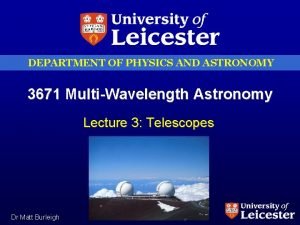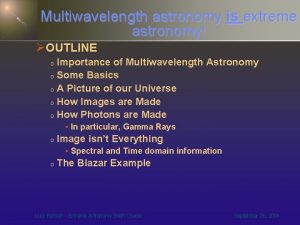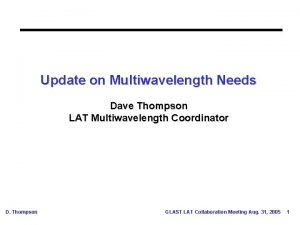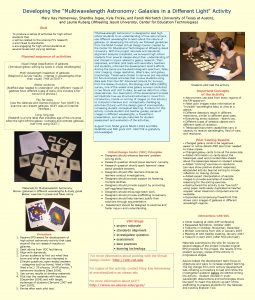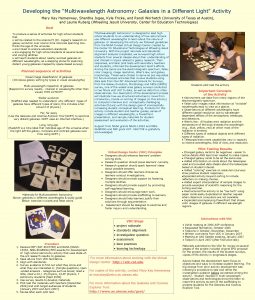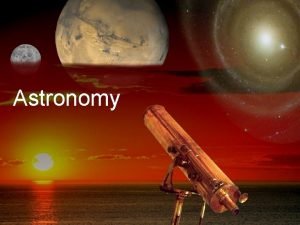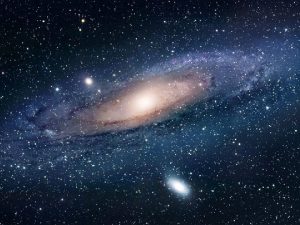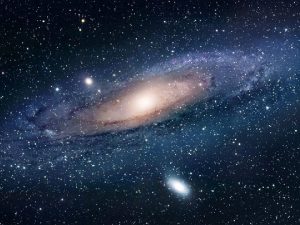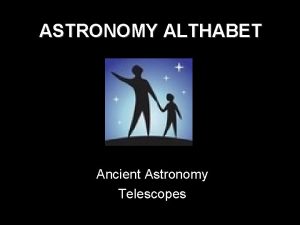Multiwavelength Astronomy Your World in Different Light Image


















- Slides: 18

Multiwavelength Astronomy: Your World in Different Light Image from NASA

Infrared Dog Image from Cool Cosmos • False color images of a dog photographed in the infrared • Which parts are hottest? Coolest? Can you normally tell just by looking?

X-Ray Challenge • This X-Ray image was taken of a closed object. • What ordinary object do you think this is? • What are the bright areas made of?

3, 000 (K • nm) max = Temperature (K) max: wavelength of maximum intensity (in nanometers) K: Kelvin nm: nanometers

Galaxy Features This is a galaxy called M 33 viewed in 5 different wavelengths… Ultraviolet: Young, Hot Stars Visible: Infrared: Most Other Stars X-Ray: Hot Gas Dust Radio: Cool Gas

Multiwavelength Astronomy Galaxies in Different Light

Crab Nebula U 5 (UIT) X 4 (Chandra) Crab (VLT) F 7 (Herschel) Multiwavelength Astronomy R 9 (NRAO)

Centaurus A X 3 (Chandra) M 7 (Spitzer) Centaurus A (NOAO) F 8 (Herschel) Multiwavelength Astronomy R 7 (NRAO)

Antennae X 5 (Chandra) M 6 (Spitzer) Antennae (Hubble) F 1 (Herschel) Multiwavelength Astronomy R 8 (VLA)

Cassiopeia A M 2 (Spitzer) X 6 (Chandra) Cassiopeia A (Hubble) F 2 (Herschel) Multiwavelength Astronomy R 11 (NRAO)

Large Magellanic Cloud X 1 (ROSAT) U 4 (Rocket) LMC (AAO) F 3 (Herschel) Multiwavelength Astronomy R 10 (RAIUB)

Triangulum X 8 (ROSAT) U 1 (UIT) Triangulum (INT) M 4 (Spitzer) Multiwavelength Astronomy R 2 (NRAO)

Orion X 2 (XMM) N 1 (VISTA) Orion (Hubble) M 3 (Spitzer) Multiwavelength Astronomy F 9 (Planck)

M 81 X 12 (Chandra) U 2 (UIT) M 81 (Gendler) F 5 (Herschel) Multiwavelength Astronomy R 1 (VLA)

M 87 X 9 (Chandra) M 5 (IRAS) M 87 (AAT) F 4 (Herschel) Multiwavelength Astronomy R 4 (NRAO)

Sombrero N 2 (2 MASS) X 10 (Chandra) Sombrero (Hubble) M 1 (Spitzer) Multiwavelength Astronomy R 3 (VLA)

M 82 X 11 (Chandra) M 8 (Spitzer) M 82 (Gendler) F 6 (Herschel) Multiwavelength Astronomy R 5 (VLA/Merlin)

Andromeda U 3 (GALEX) X 7 (XMM-Newton) Andromeda (Gendler) F 10 (Herschel) Multiwavelength Astronomy R 6 (Effelsberg)
 Learning astronomy by doing astronomy activity 1 answers
Learning astronomy by doing astronomy activity 1 answers Learning astronomy by doing astronomy activity 7 answers
Learning astronomy by doing astronomy activity 7 answers Learning astronomy by doing astronomy activity 1 answers
Learning astronomy by doing astronomy activity 1 answers Light light light chapter 23
Light light light chapter 23 Light light light chapter 22
Light light light chapter 22 Chapter 22
Chapter 22 Holy golight
Holy golight Give us your hungry your tired your poor
Give us your hungry your tired your poor Thermosoftening plastics examples
Thermosoftening plastics examples Technicolor test
Technicolor test Sound will travel at different speeds in different mediums.
Sound will travel at different speeds in different mediums. Library thinkquest org 19537
Library thinkquest org 19537 Different culture have different moral codes
Different culture have different moral codes Different angle different story
Different angle different story Different faces different places song
Different faces different places song Different materials have different
Different materials have different Things that make us different
Things that make us different Venn diagram different same different
Venn diagram different same different Properties of light
Properties of light



















